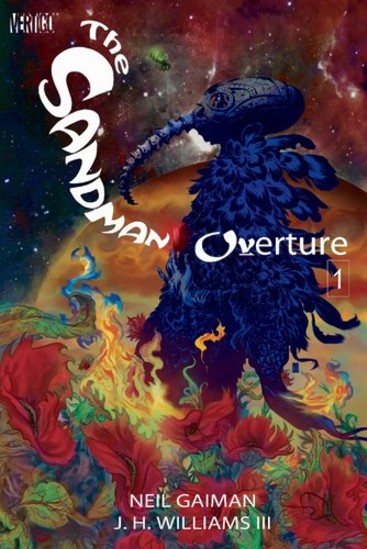
Stripped was the 2013 Edinburgh International Book Festival’s major comics strand which featured many talks and workshops with comics creators both British and from overseas. Stripped had its own blog which featured book reviews, previews of events and post event reports as well as links to video interviews with the guests and some full length video or audio recordings of the 1 hour talks.
BookFest regular Neil Gaiman rarely talks about his comics work at BookFest so it was not surprising that he rapidly sold-out this talk that Stripped entitled ‘Sandman: Time For The Untold Story’.
He may now live in America but Neil Gaiman is a regular guest at the Edinburgh International Book Festival who routinely makes several appearances each year and regularly sells out the largest tent. This year as one of the Writers In Residence he worked overtime with four different talks (and by implication four different signing sessions), one with author Margaret Attwood, one on his children’s books, one on his adult books, and one for Stripped on his comics, specifically his run on DC Vertigo’s Sandman between 1988 and 1996. That may sound like a long time ago but with the full run plus extras still available as multiple graphic novels the series is probably better known and appreciated now than it was then.
Neil began by admitting that he was paranoid in his other BookFest events that he would be saying the same things or answering the same questions but that here he knew he wouldn’t as he had not been talking about his comics work are any of the other events. That allowed creator Hannah Berry to set the event rolling by asking him that with all the other strings to his bow why he wrote comics. Neil replied to this by saying that for him as a child comics were right there from the very beginning in his head and that while adults did not understand comics he considered them as valid as any other medium. Indeed his school had printed rules that specifically banned comics and on challenging one of his English teachers on this he was told that comics were like junk food, if he read them he wouldn’t read good things – this said to the boy who had already read the contents of the school’s library.

FPI’s Joe Gordon (left) interviews Neil Gaiman (right) for the Stripped Garden Video Interview series – www.youtube.com/watch?v=zOczisfgoeo
At the age of 16 or 17 he discovered punk and girls and so left most comics behind but he would still frequent London’s comic shop of the time, Dark They Were And Golden Eyed, to get the closest thing to graphic novels that they had, books by Giles and reprints of The Spirit. In his twenties he found Dez Skinn’s Warrior comic magazine in WH Smiths, followed later by a copy of Swamp Thing in Victoria station and recognised the Swamp Thing writer’s name from Warrior – Alan Moore. This was the point that he had realised that British writers could write American comics. Since Neil had no idea how to write a comic strip he sent a copy of his movie quotes book Ghastly Beyond Belief to Alan and from this they met up at the bar of a Birmingham convention. Alan told him that he just wrote down everything in his notebook and then wrote the script from there, so Neil eventually sent some scripts to Alan which Alan described as “alright.”
Hannah took the opportunity of the audience’s appreciate of Neil’s impression of Alan Moore to move the conversation onto Sandman. While doing the high quality format Black Orchid with Dave McKean, his DC Comics editor Karen Berger phoned him to say that they were concerned that the series would not sell as he was an unknown writer who was writing about a female character and that at the time female characters did not sell well. She suggested that he write a monthly comic with an established DC character but virtually all the characters that he suggested were already spoken for until she suggested Sandman, a character that he had already suggested to her. It was the time of the 1987 hurricane and in its aftermath he sat for three or four days without electricity and thought about Sandman, eventually writing the outline for the first eight episodes. Karen wasn’t overly sure when she read the outline but her bosses overruled he and the comic was a given the green light.
At the time the time DC would let comics that weren’t commercially successful run for twelve issues before they were cancelled. While Neil hoped that it would be a critical success he was under no illusions about it and expected to receive the cancellation call around issue eight, hence the eight issue outline which he intended to follow with four one-off stories to get that twelfth issue. While Sandman wasn’t a huge commercial success at the start it did sell better than similar titles and slowly started to climb the sales charts which meant that the cancellation call never came.

Neil had never written a monthly comic before and actually wasn’t sure that he could. While prose writers normally have to come up with a limited number of plots during the year he felt that between 1987 and 1996 he was always looking for Sandman plots and sometimes it was out of desperation. With all of time to set the stories in he was aware that he could do both contemporary and historical stories and once, when asked by an assistant editor for the plot three issues in advance, he told her that he didn’t know what it was going to be. Her insistence that he made something up for her there and then resulted in the revolutionary France story. Another time, when he was much less pushed for stories, he was in the bar at the British Fantasy Convention and while looking around the people there wondered if serial killers have conventions – it was fourteen months before he could use that concept.
Sandman is returning with the first issue of the new bi-monthly six episode mini-series due out on 30 October 2013 entitled The Sandman: Overture. Neil suggested that behind-the-scenes of this new comic it was like a caper movie with him as the former leader having to pull all the old team back together with Dave McKean back on covers and JH Williams on internal artwork. Indeed he said that Jim is producing astonishing artwork that he has been buoyed up by for his problem as the writer has been stage fright. He enjoys the Sandman characters but is very aware that at the height of its sales the original monthly title was selling 120,000 copies plus the graphic novel reprints have sold many times that. He feels that all those millions of readers are looking over his shoulder at what he is writing for the new Sandman story and saying “Really?”
Time will tell if that ‘really’ is Neil’s downbeat “Really?” or the readers’ expected upbeat “Really!” However it is Neil Gaiman writing Sandman again and that must be worth an upbeat exclamation mark any day.

There are more details of all Neil Gaiman’s work on his website: www.neilgaiman.com
Neil’s personal comments on his experiences at the 2013 Edinburgh International Book Festival, including the Stripped Sandman talk, can be found here.
This event report was first posted on the Stripped Book Fest blog and is re-posted here with full permission.
News, reviews, interviews and features for print and on-line: Spaceship Away (since October 2005), Bear Alley (since February 2007), downthetubes (since June 2007), and Eagle Times (since October 2008). Plus DC Thomson’s The Art Of Ian Kennedy, Titan’s Dan Dare and Johnny Red reprints, Ilex’s War Comics: A Graphic History and 500 Essential Graphic Novels, and Print Media’s The Iron Moon and Strip magazine.
Categories: British Comics, Events, Featured News
 Reasons To Be Cheerful: Why Transformers comic creator Simon Furman loves the new Hachette partwork, out now in the UK
Reasons To Be Cheerful: Why Transformers comic creator Simon Furman loves the new Hachette partwork, out now in the UK  Walking Dead artist Charlie Adlard appointed UK’s new Comics Laureate
Walking Dead artist Charlie Adlard appointed UK’s new Comics Laureate